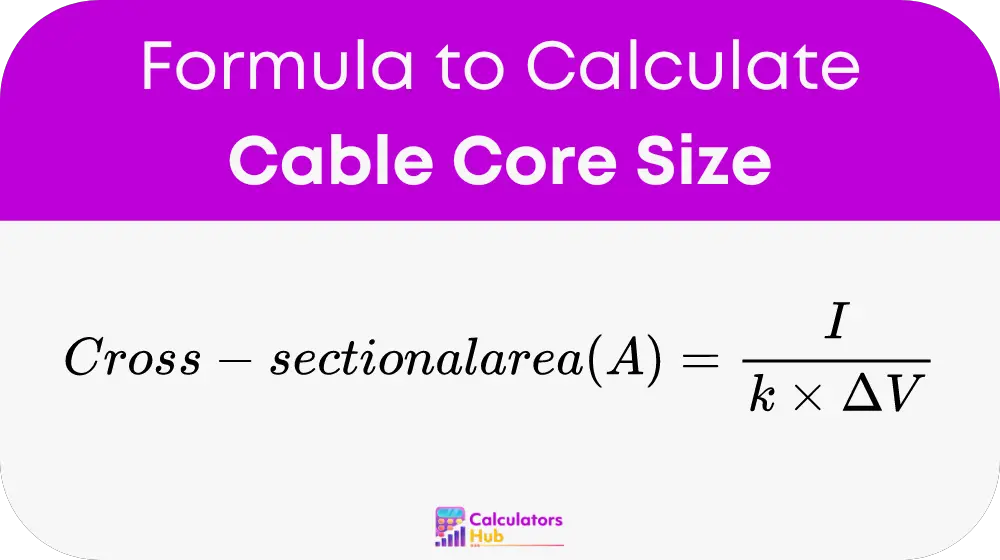The Cable Core Size Calculator is a tool used to determine the appropriate cross-sectional area of electrical cables based on factors like current, voltage drop, and conductor material. Choosing the correct cable core size is critical to ensuring electrical safety, energy efficiency, and cost-effectiveness. Undersized cables can lead to overheating, power losses, or even fire hazards, while oversized cables can increase project costs unnecessarily.
The calculator helps engineers, electricians, and DIY enthusiasts make accurate decisions when selecting cables for electrical installations, whether in residential, commercial, or industrial settings. By accounting for factors like the material of the conductor (e.g., copper or aluminum), permissible voltage drop, and the current to be carried, this calculator ensures that the selected cable size is appropriate for the application.
Formula of Cable Core Size Calculator
The formula for calculating the cable core size (cross-sectional area) is:

Where:
- I: The current in amperes (A), representing the load the cable will carry.
- k: A constant that depends on the conductor material. For copper, the value of k is typically around 56, and for aluminum, it's around 34. These values represent the conductivity of the materials.
- ΔV: The permissible voltage drop in volts (V). Voltage drop occurs when there is a reduction in voltage as electrical current flows through the cable. This drop should be minimized to maintain system efficiency.
This formula provides the minimum cross-sectional area required to handle the load while staying within a permissible voltage drop, ensuring that the electrical system operates safely and efficiently.
Common Cable Core Size Terms
Below is a table outlining key terms related to cable sizing that are helpful for understanding the calculations and ensuring safe electrical installations.
| Term | Definition |
|---|---|
| Cross-sectional Area (A) | The area of the conductor's core, typically measured in square millimeters (mm²), representing the cable size. |
| Current (I) | The electrical current the cable needs to carry, measured in amperes (A). |
| Voltage Drop (ΔV) | The reduction in voltage as current flows through the cable, which should be minimized to avoid power loss. |
| Conductor Material | The material used for the cable’s core, typically copper or aluminum, which affects its conductivity. |
| k-value | A constant representing the conductivity of the conductor material. Higher values mean better conductivity. |
| Resistance (R) | The opposition to current flow in the cable, which affects voltage drop and efficiency. |
| Permissible Voltage Drop | The maximum allowable voltage reduction in an electrical circuit, often set by national standards. |
| Ampacity | The maximum current that a cable can safely carry without overheating. |
| Single-core Cable | A cable with one conducting core, typically used for basic installations. |
| Multi-core Cable | A cable with multiple conducting cores, used for more complex installations or higher loads. |
Understanding these terms is critical for making informed decisions about cable sizing, helping to avoid problems like overheating, inefficiency, or safety hazards.
Example of Cable Core Size Calculator
Let’s work through an example of how the Cable Core Size Calculator works.
Suppose you need to choose a cable for a circuit that will carry a current of 30 amperes (A) over a distance of 50 meters, and the permissible voltage drop is 3 volts (V). You’ve decided to use copper as the conductor material, so the value of k is 56.
Using the formula:
Cross-sectional area (A) = I / (k * ΔV)
Substitute the values:
A = 30 A / (56 * 3 V)
A = 30 A / 168 = 0.1786 mm²
In this case, the minimum cross-sectional area for the cable is 0.1786 mm². Based on this calculation, you would select a cable with a cross-sectional area that meets or exceeds this value to ensure safe operation and minimal voltage drop.
Most Common FAQs
Choosing the right cable core size is crucial for preventing overheating, power losses, and potential fire hazards. An undersized cable can result in excessive heat, which may cause damage to the cable insulation, degrade system performance, or even lead to dangerous conditions. Correctly sized cables ensure that the system runs efficiently, with minimal energy loss and no safety risks.
Yes, you can use a cable that has a larger cross-sectional area than the one calculated. This is often recommended for long cable runs, higher safety margins, or future-proofing installations where you expect higher loads in the future. However, oversized cables can be more expensive and harder to work with, so it’s essential to strike the right balance between size, safety, and cost.